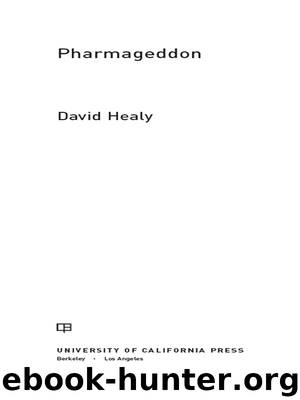Pharmageddon by David Healy

Author:David Healy
Language: eng
Format: epub
Publisher: University of California Press
FACTS ON THE GROUND
Across medicine, however misleadingly certain academic papers may be written, with a few exceptions, no studies allow claims that one drug is superior to another. Even so, a series of guidelines in different areas of medicine advocate newer, more expensive drugs over older ones. However well-meaning these may be, in these cases there should be suspicions that the guideline has been captured by pharmaceutical companies.
Capture is engineered by a combination of smart publication strategies and targeting trials at illnesses where there have been no trials before, whether restless legs syndrome, female sexual dysfunction (FSD), or osteoporosis. In these ways, companies can make diseases fashionable, can engineer the appearances of comparative efficacy, and can enlist academic advocates for particular treatment options. By these means, too, they have been able to control the content of guidelines and transform even independent guidelines into something close to an extension of company marketing departments.
This dynamic plays a key role in the selling of diseases from FSD to PTSD, overactive bladder, osteoporosis, and osteopenia.51 Getting a drug licensed for FSD or osteoporosis does not mean that physicians are thereafter enabled to treat women in a more effective way than they had been able to do before. Rather, it means that Pfizer, Lilly, and GlaxoSmithKline are enabled to start marketing these disorders and in the process to convert the vicissitudes of intimate life on the one hand or the changes of middle years on the other hand into illnesses. Guidelines achieve even more for a company—they make it appropriate, indeed almost necessary, to detect and treat these illnesses. Company-sponsored and ghostwritten “scientific” papers, along with selectively presented trial results, offer the raw material out of which clinical consensus will later be manufactured. When it comes to annexing territory, this clinical consensus in the form of guidelines establishes facts on the ground.
Consider what happens when a guideline is published. For managers running healthcare institutions, there need to be standards against which the organization can be held accountable. Whether or not the current guidelines are wrong is immaterial. If attempting to implement them produces no health gain, this still makes no difference to managers, at least in their strictly institutional role. The key point is adherence.
A celebrated episode from the fourth series of the American TV medical drama House shows Dr. Foreman grappling with a patient’s life-threatening problem. He ultimately finds an unorthodox answer to it that saves his patient’s life but gets him the sack. As his boss tells him, it may have been good medicine but it was bad practice. Dr. Foreman is not alone; clinicians worldwide are increasingly faced with managers enquiring about their compliance with guidelines and more and more are getting the sack. What’s a manager going to do if a doctor retorts that these ostensibly evidence-based guidelines amount to pharmaceutical marketing by proxy?
The accountants in the finance department of a healthcare organization who see the figures on newer and more costly drugs also find themselves faced with guidelines supporting the
Download
This site does not store any files on its server. We only index and link to content provided by other sites. Please contact the content providers to delete copyright contents if any and email us, we'll remove relevant links or contents immediately.
Good by S. Walden(2930)
The Social Psychology of Inequality by Unknown(2332)
0041152001443424520 .pdf by Unknown(2241)
The Checklist Manifesto by Atul Gawande(2221)
The Meaning of the Library by unknow(2082)
23:27 by H. L. Roberts(1899)
Guns, Germs and Steel by Diamond Jared(1897)
Being Mortal: Medicine and What Matters in the End by Atul Gawande(1817)
Borders by unknow(1798)
A Leg to Stand On by Oliver Sacks(1720)
The Hot Zone by Richard Preston(1648)
And the Band Played On by Randy Shilts(1632)
The Valachi Papers by Peter Maas(1523)
The Obesity Epidemic by Robyn Toomath(1433)
The Laws of Medicine by Siddhartha Mukherjee(1424)
The Andromeda Strain by Michael Crichton(1374)
The Plague and I by Betty Macdonald(1272)
Pharmacy Practice and The Law by Richard Abood(1262)
Autism's False Prophets by Paul A. Offit(1249)
